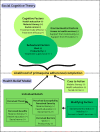A mixed methods study investigating factors affecting adherence to Plasmodium vivax malaria primaquine radical cure regimens among migrants along the Myanmar-Thailand border
- PMID: 39820011
- PMCID: PMC11737701
- DOI: 10.1371/journal.pgph.0003615
A mixed methods study investigating factors affecting adherence to Plasmodium vivax malaria primaquine radical cure regimens among migrants along the Myanmar-Thailand border
Abstract
Background: The countries within the Greater Mekong Region of Southeast Asia have pledged to eliminate malaria by 2030. Elimination of Plasmodium vivax malaria is challenging as it requires radical cure to prevent relapse. Understanding and facilitating adherence to primaquine radical cure regimens is necessary for malaria elimination.
Methods: A convergent parallel mixed methods study was conducted to investigate the barriers to and facilitators for completing primaquine treatment of P. vivax infection among mobile migrant communities on the Myanmar-Thailand border. Quantative data were derived from routine malaria consultations. Qualitative data, informed by the social cognitive theory and health belief model, were collected through in-depth interviews with patients and focus group discussions with local health providers and community leaders.
Results: Of 729 adult patients with primaquine treatment outcomes, 45% did not complete the follow-up of 28 days and were assumed to be non-adherent to primaquine treatment. Patients of Karen ethnicity (OR 1.7, 95% CI 1.2-2.3; p = 0.001) or having a previous episode of malaria from any species (OR 1.6, 95% CI 1.1-2.3; p = 0.007) were more likely to report completing the 14-day primaquine radical cure regimen. Five focus group discussions with front-line healthcare workers and community members and 16 in-depth interviews with patients who were prescribed P. vivax radical cure were conducted. Key themes related to the social cognitive theory included behavioral factors where work outweighed the choice to complete treatment; environmental factors where access to care determined primaquine treatment completion; and cognitive factors having a positive but limited influence on treatment completion. According to the health belief model, prioritizaton of work reduced seeking diagnosis and completing treatment, and often outweighed facilitating factors such as malaria literacy, health education, and social norms; and affected the perceived susceptibility and severity of P. vivax infections.
Discussion: Work and productivity were identified as primary behavioral factors affecting adherence to primaquine radical cure and follow up in a migrant population. Community support and cultural cues may overcome these barriers. Understanding the rationale of patient adherence to primaquine may help guide programming for P. vivax elimination among migrant populations in resource-constrained settings.
Copyright: © 2025 Ansari et al. This is an open access article distributed under the terms of the Creative Commons Attribution License, which permits unrestricted use, distribution, and reproduction in any medium, provided the original author and source are credited.
Conflict of interest statement
The authors have declared that no competing interests exist.
Figures




Similar articles
-
Interventions for promoting patients' adherence to 14-day primaquine treatment in a highly malaria-endemic township in Myanmar: a qualitative study among key stakeholders.Malar J. 2023 Oct 9;22(1):302. doi: 10.1186/s12936-023-04743-8. Malar J. 2023. PMID: 37814267 Free PMC article.
-
Directly-observed therapy (DOT) for the radical 14-day primaquine treatment of Plasmodium vivax malaria on the Thai-Myanmar border.Malar J. 2010 Nov 1;9:308. doi: 10.1186/1475-2875-9-308. Malar J. 2010. PMID: 21040545 Free PMC article. Clinical Trial.
-
Interventions for promoting patients' adherence to 14-day primaquine treatment in a highly malaria-endemic township in Myanmar: A qualitative study among key stakeholders.Res Sq [Preprint]. 2023 Sep 6:rs.3.rs-3312278. doi: 10.21203/rs.3.rs-3312278/v1. Res Sq. 2023. Update in: Malar J. 2023 Oct 9;22(1):302. doi: 10.1186/s12936-023-04743-8. PMID: 37720045 Free PMC article. Updated. Preprint.
-
Primaquine at alternative dosing schedules for preventing relapse in people with Plasmodium vivax malaria.Cochrane Database Syst Rev. 2019 Jul 5;7(7):CD012656. doi: 10.1002/14651858.CD012656.pub2. Cochrane Database Syst Rev. 2019. Update in: Cochrane Database Syst Rev. 2020 Aug 19;8:CD012656. doi: 10.1002/14651858.CD012656.pub3. PMID: 31274189 Free PMC article. Updated.
-
Plasmodium vivax in Children: Hidden Burden and Conspicuous Challenges, a Narrative Review.Infect Dis Ther. 2023 Jan;12(1):33-51. doi: 10.1007/s40121-022-00713-w. Epub 2022 Nov 15. Infect Dis Ther. 2023. PMID: 36378465 Free PMC article. Review.
References
-
- Cheoymang A, Ruenweerayut R, Muhamad P, Rungsihirunrat K, Na-Bangchang K. Patients’ adherence and clinical effectiveness of a 14-day course of primaquine when given with a 3-day chloroquine in patients with Plasmodium vivax at the Thai–Myanmar border. Acta tropica. 2015;152:151–6. doi: 10.1016/j.actatropica.2015.08.008 - DOI - PubMed
Grants and funding
LinkOut - more resources
Full Text Sources
